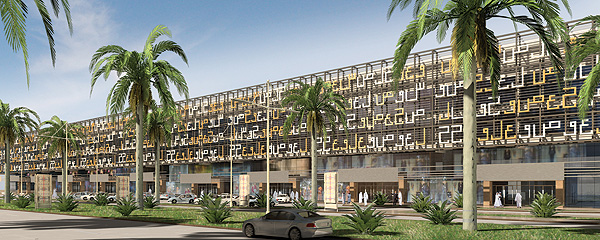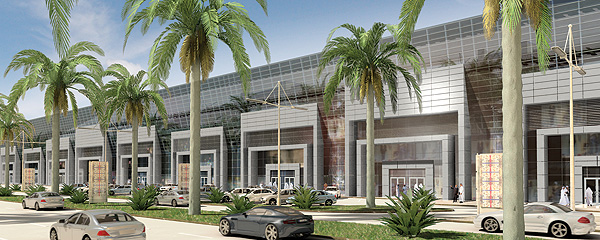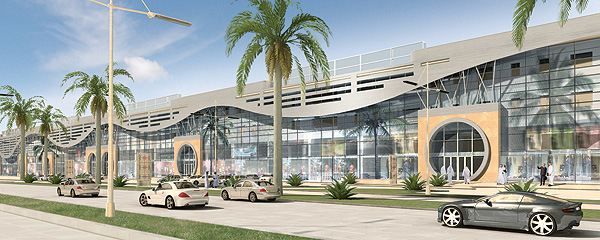EPLASS
Qatar has been experiencing vast economic growth in the recent years. One such symbol of development is the nearly 8.6 kilometre long shopping street called the ‘Barwa Commercial Avenue’ (BCA) in the capital city, Doha.
EPLASS Project Collaboration – A good strategy in modern project management
Qatar has been experiencing vast economic growth in the recent years. One such symbol of development is the nearly 8.6 kilometre long shopping street called the ‘Barwa Commercial Avenue’ (BCA) in the capital city, Doha.
The project entails a mixed expansion of buildings consisting of commercial complexes, showrooms and residential units. The project consists of five main buildings, each with its own architectural style.
Built along a highway at Doha’s southern fringe – between the Mesaimeer roundabout and the industrial area – the entire project comprises of 920,000 square metres of gross floor space -including an architectural facade area of 340,000 m². The floor space contains approximately 600 retail spaces and nearly 1300 residential units and offices, while public areas will have food courts, groceries, pharmacies and other amenities for people living and working in the Barwa Commercial Avenue.
HOCHTIEF Solutions Middle East Qatar W.L.L., the local subsidiary of HOCHTIEF Solutions AG, was awarded in 2008 for carrying out the construction of the 65-metrewide boulevard, including the 24-metre wide building with all related utilities and infrastructure works in- and outside the building. The contract value for HOCHTIEF to execute the works was approx. 1.4 billion euro. More than 60,000 different staff and workers were involved with the project in total, with nearly 15,000 people working at the peak times on the construction site.
 The project had been handed over by HOCHTIEF to the client BARWA Real Estate Company within the contractual time frame in various sections, between the end of 2011 and June 2012, with the exception of the 950-metre long Building Type 3 which had been redesigned by the client into a shopping mall and for which, as such, an extension of time was required. Building Type 3 was eventually handed over at the end of 2012 to BARWA, with testing & commissioning activities being in its final stage. It is worth mentioning that most parts of the building works had to be constructed by HOCHTIEF as shell & core only, while later fit-out works are being done by the future tenants, under the client’s direct co-ordination (currently on-going).
The project had been handed over by HOCHTIEF to the client BARWA Real Estate Company within the contractual time frame in various sections, between the end of 2011 and June 2012, with the exception of the 950-metre long Building Type 3 which had been redesigned by the client into a shopping mall and for which, as such, an extension of time was required. Building Type 3 was eventually handed over at the end of 2012 to BARWA, with testing & commissioning activities being in its final stage. It is worth mentioning that most parts of the building works had to be constructed by HOCHTIEF as shell & core only, while later fit-out works are being done by the future tenants, under the client’s direct co-ordination (currently on-going).
Economisation through cloud project collaboration
HOCHTIEF is one of the world’s leading construction groups, with a more than 140 years history in construction. With almost 80,000 employees and a sales volume of 25.53 billion euro in 2012, the company is represented in all the world’s major markets. The 2013 ranking from Engineering News- Record magazine reaffirmed the Group’s status as one of the world’s most international providers, with over 90 per cent of sales outside of Germany.
The international expansion has led to significantly increased requirements in the project management. In addition, there is less time for the development. Design and construction are often parallel processes. Therefore it is necessary to exploit all possibilities for rationalisation and improvement for an efficient execution of complex projects. In this context the electronic management of drawing approval was of great importance.
On the Barwa Commercial Avenue Project, HOCHTIEF used EPLASS project collaboration for the entire drawing administration including the necessary review and approvals. The designers and design co-ordinators of the various entities, being engaged in such mega-size project, were linked together in EPLASS from different locations.
Pre-defined workflows manage complex process
In today’s complex and decentralised projects, a modern drawing management platform is a must. The integration of all parties involved in the project by predefined Workflows obtain a high security design level and save valuable time and significant design costs. Paper consumption is also reduced since only the copies of documents that are really required have to be printed or plotted – often in a reduced size, which means lower costs for the designers, design co-ordinators, the construction teams and the project management.
For an effective, on-time and in-budget delivery of the project, many companies from around the world had to be able to work together. EPLASS with its powerful Workflow capabilities was able to meet HOCHTIEF’s project requirements, management and monitoring of the geographically dispersed project participants. Alone HOCHTIEF’s subcontractors and detailed designers in the BCA project consisted of approximately 40 different firms from three continents; which were granted specific view-rights access to the online platform for an easy submission of their shop drawing packages.
 At the beginning of the project, an EPLASS consultant together with the HOCHTIEF design manager defined the required review processes as ‘design workflows’, together with the respective access rights for each user and discipline. These were then implemented into the EPLASS Workflows to provide the diversely required access controls, such as view rights, drawing editing rights and approval rights for various designers, design co-ordinators, subcontractors or client’s representatives.
At the beginning of the project, an EPLASS consultant together with the HOCHTIEF design manager defined the required review processes as ‘design workflows’, together with the respective access rights for each user and discipline. These were then implemented into the EPLASS Workflows to provide the diversely required access controls, such as view rights, drawing editing rights and approval rights for various designers, design co-ordinators, subcontractors or client’s representatives.
EPLASS project collaboration also enabled HOCHTIEF to work with an unlimited number of Workflows such as those needed for preliminary review, shop drawing review, as built review and also submittals such as request for information (RFI) review. The automated administration of drawing revision control ensured that project participants were always working with the latest version and that the correct documents were being dispatched to reproduction firms for plotting and given to site for construction. This is yet another action automated by the EPLASS Workflow engine in order to reduce manual administration and to improve quality control of documents.
Keeping progress in focus
Over the past decade, the requirements of project control, including the drawing and document management have risen. The projects are expected to be completed in more limited time. The designers, civil engineers and the building sites have to be networked worldwide in a shorter amount of time. Hence the co-ordination through a project collaboration platform is inevitable.
That is where EPLASS came in. EPLASS enabled all drawings from the designers to be created and filed within the Cloud. The Workflows then automatically distributed all the documents to the predefined review disciplines. Each project participant received only the drawings for which they were responsible to review. Yet working in a central area, all participants were allowed to view the drawings and the mark-ups as soon as they were released. All additional documents such as, check reports, bill of quantity, specifications, etc. were easily attached to a drawing or a package as a link.
The digital signature on approved drawings was protected through a password and stamped automatically on the title block together with other information such as the release status, and thus created a smooth interface with the paper world. In other words, the document status in the Workflow was clearly presented on paper as well. The drawings were digitally stamped ‘ready for construction’ as soon as the last checking authority released the drawing electronically.
 EPLASS allowed ‘electronic approval of the drawing’, even from the various authorities. This procedure has been in practice for over a decade by the Federal Railway Authorities, the National Highway Authorities and the Road Authorities in Germany.
EPLASS allowed ‘electronic approval of the drawing’, even from the various authorities. This procedure has been in practice for over a decade by the Federal Railway Authorities, the National Highway Authorities and the Road Authorities in Germany.
Automated schedule management
EPLASS’ distinctive time scheduling functionality (via the review period allocation and assignment of milestones in the Workflow) made it possible to accommodate different review periods for different disciplines. For calculation of the contractually correct review period, EPLASS also ensured the accurate incorporation of the Qatari public holidays and weekends. This monitoring tool was especially favoured, as EPLASS automatically and periodically created lists with traffic light symbols. These graphic analyses were based on MS Excel reports and they displayed both the ‘current’ schedule state (including the possible delays) for each task as well as the overall review timetable.
The powerful Workflow engine of EPLASS made it possible for the right design packages to be delivered to the right disciplines for review without need for manual administration. It further facilitated the project communication by delivering automated notifications and task emails to the responsible project participants. The steadfast integration of Workflows also provides graphic comparison between planned and actual states for timekeeping.
The use of EPLASS on the Barwa Commercial Avenue project demonstrated a technically effective and cost efficient platform for project collaboration, which enabled the worldwide preparation and the implementation of a building project on the basis of the internet technology.
Central serverfarm (Cloud) & local installations (On-Premise)
On the basis of the SaaS (Software as a Service) model, the EPLASS platform was set up for use in the cloud with an access via the terminal server solution (CITRIX). However, to make the review process for the client’s team (with AECOM acting as BARWA’s designer and technical consultant) quicker and more convenient, in other words, independent of the internet connection of that time, a local installation solution was installed on-site.
The server farm on the cloud operated according to the latest security guidelines (such as data integrity, virus protection concept, security concept / ‘worst-case-scenario’, security needs and security goals, ensured availability and security of our data – confidentiality, etc). Further safety measures included a complete daily backup on tapes resp. provision of the data on several servers, which are independent from each other (saved on different clusters). The SSL encryption was also a standard safety measure ensured regularly by EPLASS.
The addition alternative used was the installation of EPLASS on local PCs and servers parallel to those on the cloud. The replication ran every hour to synchronise the data with the server farm in the background, which ensured that all data is physically available on our local computers. This option was a critical need in order to meet the client’s requirements as the internet connection was not always stable. The on-premise solution provided a higher performance, due to the fact that the processing of the data was being made locally while the replication was being made in the background via the slow connection
Armin Krimpmann, (HOCHTIEF Solutions AG – Department Manager of Planning and Reporting on the BARWA Commercial Avenue Project)
Christoph Duempelmann-Berner (HOCHTIEF Solutions AG – Dep. Project Director on the BARWA Commercial Avenue Project)
Marzi Strutzke – Project Manager, Business Development Manager, EMEA
EPLASS Project Collaboration GmbH Berliner Platz 9 97080 Würzburg, Germany.
marzi.strutzke@eplass.com
http://www.eplass.com